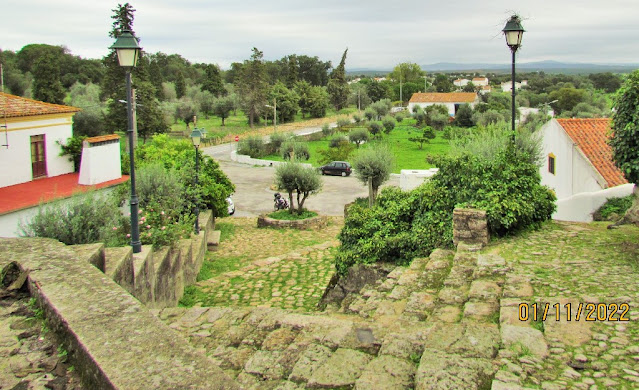CRATO
N 39.28680° ; W 7.64762º
It is the seat of the municipality of Crato with an area of 398.07 km² and 3,225 inhabitants (2021), subdivided into 4 parishes. (Aldeia da Mata; Crato e Mártires, Flor da Rosa e Vale do Peso (Crato);
Gáfete; Monte da Pedra)
The municipality is limited to the northeast by the municipalities of Gavião, Nisa and Castelo de Vide, to the east by Portalegre, to the southeast by Monforte and to the southwest by Alter do Chão and Ponte de Sor.
The Monastery of Santa Maria de Flor da Rosa, also referred to as Monastery of the Order of the Hospital of Flor da Rosa, Church of Flor da Rosa, Convent of Flor da Rosa, Paço de Flor da Rosa and Pousada da Flor da Rosa, is located in Flor da Rosa, in the parish of Crato e Mártires, Flor da Rosa and Vale do Peso, municipality of Crato, district of Portalegre, in Portugal.😚😚😚😚😚😚
FLOR DA ROSA
N 39.30666°; W 7.64686°
Flor da Rosa Monastery
Considered the most important example of a fortified monastery on the Iberian Peninsula, it now houses one of the units of the Pousadas de Portugal (historic hotels in the most beautiful palaces, monasteries and castles).
History
Ordered to be built in 1356 by D. Álvaro Gonçalves Pereira, first Prior of Crato and father of the Holy Constable, D. Nuno Álvares Pereira was, according to historians, the birthplace of this.
In 1232 King D. Sancho II donated the town of Crato to the Order of Hospitallers. It was in 1340 that the seat of the Order of the Hospital was moved from Leça do Bailio or Belver to Crato, with the Prior of Crato, D. Álvaro Gonçalves Pereira, soon deciding to found a chapel in the locality. With the growth of the Order, this Monastery was built, the mother house of the Order in Portugal, founded in 1356. From the 16th century onwards, the Order of the Hospital was renamed the Order of Malta, a name that it still retains today.
Currently, the Monastery houses the founder's tomb, a Luxury Pousada Hotel and the Medieval Sculpture Nucleus of the National Museum of Ancient Art.
The monument is open to the visiting public with a reception and interpretation area where different support services are available that allow a better understanding of the entire history of this place and the appropriate reception conditions It was possible to install the Medieval Sculpture Nucleus of the National Museum of Ancient Art and an exhibition of sculptures by João Cutileiro, in the church's nave.
POUSADAS OF PORTUGAL – LUXURY POUSADA HOTELS
The Pousadas of Portugal Group is an exclusive chain of 34 historical hotels many of which are considered to be amongst the top hotels in Portugal and are the very embodiment of the best that Portugal has to offer. Many Pousada hotels were formerly monasteries, palaces, convents and castles and have been beautifully converted to offer luxurious, elegant hotel accommodations, often in superb locations. These unique hotels are located throughout mainland Portugal and the Azores in either historical cities such as Evora, a world heritage site, or in rural areas of outstanding natural beauty or interest such as Geres National Park.
FLOR DA ROSA
Flor da Rosa was a Portuguese parish in the municipality of Crato, with an area of 9.91 km² and 263 inhabitants (2011). Density: 26.5 inhabitants/km².
There are those who attribute to Flor da Rosa and its monastery the birthplace of the Holy Constable, D. Nuno Álvares Pereira, due to his father, D. Álvaro Gonçalves Pereira, having lived there when Prior of Crato, having been erected in that locality a statue in honor of the Holy Constable.
A village with a great tradition in the making of clay pieces, it has 14 pieces certified as Flor da Rosa pieces and a pottery school is still in operation.
Very rich in architectural heritage, it has, in addition to the Monastery of Santa Maria de Flor da Rosa, two fountains from the 15th century and two Baroque manor houses (one of them adapted for a rural tourism establishment).
Also noteworthy are the houses of popular architecture, manor houses, in the Baroque style, and the Church.
There are those who attribute to Flor da Rosa and its monastery the birthplace of the Holy Constable, D. Nuno Álvares Pereira, due to his father, D. Álvaro Gonçalves Pereira, having lived there when Prior of Crato, having been erected in that locality a statue in honor of the Holy Constable.
A village with a great tradition in the making of clay pieces, it has 14 pieces certified as Flor da Rosa pieces and a pottery school is still in operation.
Very rich in architectural heritage, it has, in addition to the Monastery of Santa Maria de Flor da Rosa, two fountains from the 15th century and two Baroque manor houses (one of them adapted for a rural tourism establishment).
Also noteworthy are the houses of popular architecture, manor houses, in the Baroque style, and the Church.































































































































































































































































